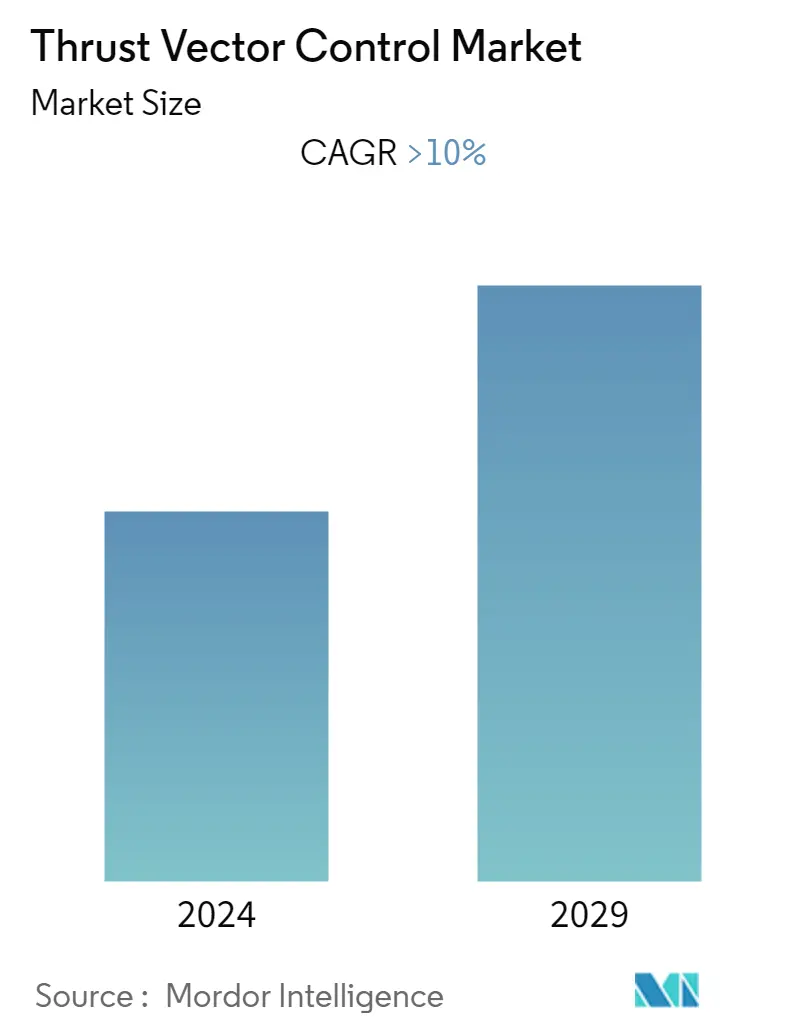Market Size of Thrust Vector Control Industry

| Study Period | 2020 - 2029 |
| Base Year For Estimation | 2023 |
| CAGR | 10.00 % |
| Fastest Growing Market | Asia-Pacific |
| Largest Market | North America |
| Market Concentration | High |
Major Players
*Disclaimer: Major Players sorted in no particular order |
Thrust Vector Control Market Analysis
The thrust vector control market is anticipated to register a CAGR of over 10% during the forecast period.
- The COVID-19 pandemic severely impacted the global market for thrust vector control. Lockdowns enforced by governments resulted in original equipment manufacturers (OEMs) shutting down production, supply chain disruptions, and a decline in space exploration activities, all of which hampered the market's growth. However, the market has shown a strong recovery since then, and it is expected to grow in the coming years, driven by an increase in defense spending and rising space programs.
- Thrust vector control (TVC) is a crucial component of aerospace maneuvering, enabling an aircraft, rocket, or launch vehicle to change its flight direction by altering the thrust from its engine. The market is expected to grow during the forecast period due to an increase in the implementation of thrust vector control in fighter aircraft, growing space programs, and rising adoption of thrust vector control in next-generation guided missile systems. Furthermore, the use of flex nozzles in satellite launchers and missile systems for high-actuation power is expected to boost the market growth.
- In summary, the rising adoption of thrust vector control in fighter jets, the growing defense expenditure, and the increasing use of thrust vector control in missile systems and satellite launchers are anticipated to drive the market's growth.
Thrust Vector Control Industry Segmentation
Thrust vector control (TVC), also known as thrust vectoring, is the ability of a fighter aircraft, rocket, or another launch vehicle to manipulate the direction of the thrust from its engine or motors to control the attitude or angular velocity of the vehicle.
The thrust vector control market is segmented based on application, end user, and geography. By application, the market is segmented into launch vehicles, satellites, missiles, and fighter aircraft. By end user, the market is divided into space agencies and defense bodies. By geography, the market is segmented into North America, Europe, Asia Pacific, Latin America, and the Middle East and Africa.
The market sizing and forecasts have been provided in value (USD Billion) for all the above segments.
| Application | |
| Launch Vehicles | |
| Satellites | |
| Missiles | |
| Fighter Aircraft |
| End User | |
| Space Agencies | |
| Defense |
| Geography | |||||||
| |||||||
| |||||||
| |||||||
| |||||||
|
Thrust Vector Control Market Size Summary
The thrust vector control systems market is poised for significant growth, driven by increasing defense spending and the expansion of space programs. Thrust vector control, essential for aerospace maneuvering, allows aircraft, rockets, and launch vehicles to alter their flight direction by adjusting engine thrust. The market's recovery from the COVID-19 pandemic's disruptions is fueled by the rising implementation of these systems in fighter aircraft and next-generation guided missile systems. The use of flex nozzles in satellite launchers and missile systems is also expected to contribute to market expansion. The defense sector, in particular, is set to experience substantial growth due to the procurement of super maneuverable fighter aircraft and the increasing adoption of thrust vector control in long-range and intercontinental ballistic missiles.
North America is anticipated to maintain its dominant position in the market, supported by high defense expenditure and active space exploration initiatives. The region's market growth is further bolstered by the procurement of fighter jets with thrust vector control and a rising number of satellite launches. The market is characterized by consolidation, with key players like Honeywell International Inc., Moog Inc., and BAE Systems holding significant shares. These companies are focusing on developing advanced thrust vector control solutions for space and defense applications, driven by increased research and development spending. The successful deployment of these systems in high-profile missions, such as NASA's Artemis 1, underscores their critical role in modern aerospace applications.
Thrust Vector Control Market Size - Table of Contents
-
1. MARKET DYNAMICS
-
1.1 Market Overview
-
1.2 Market Drivers
-
1.3 Market Restraints
-
1.4 Porter's Five Forces Analysis
-
1.4.1 Bargaining Power of Buyers/Consumers
-
1.4.2 Bargaining Power of Suppliers
-
1.4.3 Threat of New Entrants
-
1.4.4 Threat of Substitute Products
-
1.4.5 Intensity of Competitive Rivalry
-
-
-
2. MARKET SEGMENTATION
-
2.1 Application
-
2.1.1 Launch Vehicles
-
2.1.2 Satellites
-
2.1.3 Missiles
-
2.1.4 Fighter Aircraft
-
-
2.2 End User
-
2.2.1 Space Agencies
-
2.2.2 Defense
-
-
2.3 Geography
-
2.3.1 North America
-
2.3.1.1 United States
-
2.3.1.2 Canada
-
-
2.3.2 Europe
-
2.3.2.1 United Kingdom
-
2.3.2.2 France
-
2.3.2.3 Germany
-
2.3.2.4 Russia
-
2.3.2.5 Rest of Europe
-
-
2.3.3 Asia-Pacific
-
2.3.3.1 China
-
2.3.3.2 India
-
2.3.3.3 Japan
-
2.3.3.4 South Korea
-
2.3.3.5 Rest of Asia-Pacific
-
-
2.3.4 Latin America
-
2.3.4.1 Brazil
-
2.3.4.2 Rest of Latin America
-
-
2.3.5 Middle-East and Africa
-
2.3.5.1 Saudi Arabia
-
2.3.5.2 United Arab Emirates
-
2.3.5.3 South Africa
-
2.3.5.4 Rest of Middle-East and Africa
-
-
-
Thrust Vector Control Market Size FAQs
What is the current Thrust Vector Control Market size?
The Thrust Vector Control Market is projected to register a CAGR of greater than 10% during the forecast period (2024-2029)
Who are the key players in Thrust Vector Control Market?
Honeywell International Inc., Moog Inc., Woodward Inc., JASC Corporation and BAE Systems PLC are the major companies operating in the Thrust Vector Control Market.

